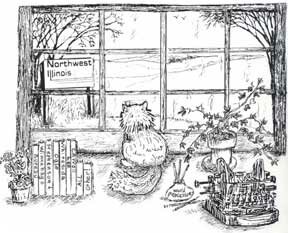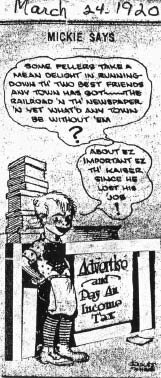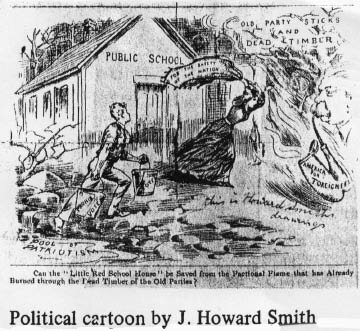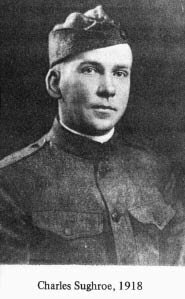
Discover rewarding casino experiences. 

Please Don't Quote Me Al Capp, Chic Young, Mort Walker are familiar names to readers of the comic pages, each creating characters that became familiar over the long years they appeared. Comics noted for their humor and insight. Yes, insight. Cartoons/comics portray a slice of life or some current event and not just those that are featured on the editorial pages. |
Many cartoons have spanned several generations or readers and their artists, often times the son of the original artist making it a family arrangement. Charles Sughroe, Stockton, had no one to continue his perceptive ideas or characters such as Bill the Booster or Mickie, the Printer’s Devil. His ideas came directly from people and occurrences in the Ol’ Home Town. Or he would mention them in his newspaper column, “Our Town” which was more well-known locally than Thornton Wilder book/play ever would be. Sughroe was a longtime editor of the “Stockton Herald-News,” bringing to it a constant stream of news, creativity, thoughtfulness, practicality and, yes, insight. In our “series” about area cartoonists, Charles Sughroe may be the least known of syndicated artists. He’s the most famous artist you’ve never heard of! But his subjects and style were much beloved by a host of loyal readers. He really was the “local boy made good.” John Sughroe, his father (or Suhgroue) was a native of Pleasant Valley, a settlement-neighborhood about halfway between Mt. Carroll and Stockton. The elder Sughroe became an attorney in Mt. Carroll and published the “Mt. Carroll Mirror.” At about that time a young man from Rochester, New York decided to Go West. With a pile of cumbersome equipment to use to print a newspaper, he traveled by train to the upper northwest of Illinois because a new railroad was being laid, with depots sprouting up along the way that would need a newspaper. John Klock was his name. He arrived in a new depot/market in the spring of 1888 to begin publishing the “Stockton Herald.” He had the true pioneer spirit although frontier days were well past. He did see the potential of the fertile agricultural region and how a newspaper could help promote it. A newspaper was a never-fail booster of its surroundings, the everyday life that accompanied each. John Klock sold the Herald in 1893 to move to Michigan to publish a daily paper instead of a weekly. He eventually became a prominent, well-to-do businessman in Benton Harbor, Michigan but included many memories of his Stockton years in a book he later wrote. The year following his departure, 1894, John Sughroe bought the Herald from the two men who’d purchased it from Klock.
Sughroe also saw the potential of the beautiful landscape, fertile soil, the herds of livestock that could be raised along with endless crops. He set out to boost them as well. He became impressed with the rapid rise and growth as the area developed. Competition arrived, however, in 1898 when another newspaper was added to the roster of Stockton businesses, the “News.” The rivalry continued until 1919 when shrewd thinking determined that two newspapers in a town the size of Stockton was one too many. Sughroe bought the News and combined the names into “Stockton Herald-News” in 1912. Sughroe’s son, Charles, contributed to the newspaper columns his first cartoon. He loved to draw and had decided to become an artist at that early age. Of course, in the newspaper business, family is often staff, so Charles helped at the paper in many ways, “groomed,” as they say to one day take charge! Meanwhile the benefits of small town/rural living added to the life experiences that came from the pen of the future Charles Sughroe both in the practical, personal way that he wrote and in the clever drawings he did for the Herald-News. His talent for drawing and painting culminated in going to Chicago to the Art Institute to school hoping to pursue an art career. He had become acquainted with two other local artists-illustrators, Nate Collier, Pearl City and Howard Smith of Pleasant Valley, his dad’s home when young. They had all three graduated from the Art Institute so felt a kinship for that reason, too. The other two both became noted in their field. Collier in cartooning and Smith for his excellence in portraiture, the western genre and outdoor life seen then in men’s sport magazine. (The Stockton Heritage League has had several of his canvas’ on display.) In 1916, too, Smith submitted a cartoon to the Herald-News and one is pictured here. He, too, used “home-grown” ideas for his subject.
World War I in Europe loomed. Sughroe’s career plans were put on hold and he was inducted into the Army at Camp Grand, Rockford in February, 1918. He once wrote home soon after enlisting, “Living conditions are as fine as possible for a rich and grateful government can make them—good food, good beds, all is clean and sanitary.” Three months later, however, ominous news emanated from the barracks ... The influenza was rampant, 103 died within twenty-four hours. Charles escaped the epidemic but was sent to France in late 1918. All the time at school and in the military he had sent cartoons home to be used in the Herald-News. They were a great emotional lift home and abroad. At war’s end he expected he’d find some job in the art world but his father wanted him to come back to Stockton and work at the newspaper. Some sources said he was quite disappointed, reluctant, but did as his father wished. The years marched on. In 1921 he married Marie Donahue and they had one daughter together, Patricia, who like her dad, sent home messages from college that were printed in the town paper by now under the ownership of Charles. John Sughroe was bedridden for three years and died in 1935. His name remained on the masthead until the paper was sold nearly twenty years later. Marie Sughroe, like many an editor’s wife worked beside her husband at the newspaper and they made a success of it. Small town events, progress, developments, good news and bad were printed weekly in the Herald-News but always the editor promoted Stockton. He felt it his goal to make the best he could of what went on. He was a true booster. That idea led him to write “Our Town” and other various series such as “Main Street Folks;” “Home Town Henry;” “Eddie, the Ad Man;” “Folks We Know;” “Print Shop Callers;” “Old Grouch;” “Golf Chuckles” and “Bill Booster.” The latter led to a unique series in 1929 that ran throughout the year, cartoons of 50-60 Stockton businessmen and some clever anecdote about them (the pictures here, by the way, are from the files of the Stockton Library. Thanks!!) He reminded the readers, “A feature such as this is frequently seen in large city newspapers. This is the first time we know where a country-newspaper has been able to give its readers such a treat.” Bill Booster, er, Charles Sughroe, was a popular feature and examples of it are in the files of the Heritage League. Archives also extant of records show Sughroe’s syndication of “Mickie the Printer’s Devil (the go-fer). Such notes indicate that Sughroe wasn’t just “local” in distribution of his works. They were distributed to other periodicals. Mickie was, note says, in syndication as early as 1918. Other information would take additional search at the Heritage League. Like Claire Bloom, Dixon, or Nate Collier, Pearl City, they too made royalties through their works being circulated to various newspapers which tells us that many readers enjoyed the work of our home town artists.
Charles Sughroe guided the Herald-News until the summer of 1958 when his health having declined he was unable to work. The newspaper was sold to Ruth and Charles Becker, and other owners since. Booster, artist, reporter, writer, philosopher, humorist Charles Sughroe died September 12, 1958 after a lifelong association with the Stockton community who were his neighbors. The obituary read in part: “CREATOR OF “OUR TOWN” IS GONE.” A brilliant and widely-known businessman, Charles Sughroe has laid aside his pen, his brush and his make-up rule to leave the locality in which he was so deeply interested for a sojourn in another land. Shall it be a promotion for a job well done?”
|






